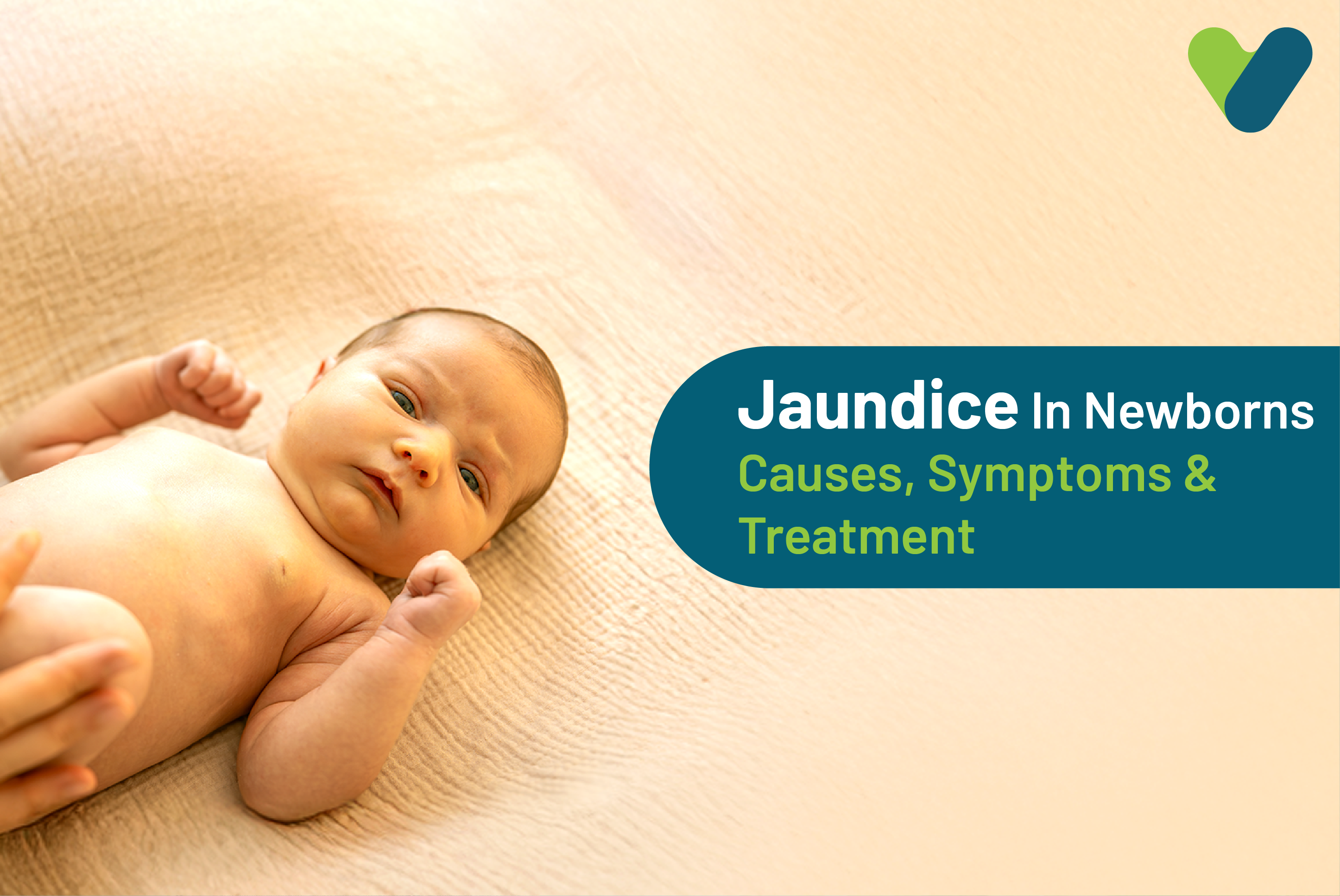Jaundice in newborn babies is common and usually harmless. It is typically brought on by high amounts of bilirubin, a pigment created when red blood cells break down. Jaundice is frequently transient and harmless. Untreated instances, however, may result in serious problems. Therefore, early detection and management are essential. This guide discusses jaundice in newborns. It investigates its forms, origins, signs, diagnosis, therapy, and avoidance. It seeks to support parents and other caregivers in maintaining the safety and well-being of their newborns.
What Is Jaundice in Newborns?
Babies with jaundice have yellow skin and eyes. This happens when there is too much bilirubin in the baby's blood.- The regular decomposition of red blood cells produces bilirubin, a yellow pigment (bill-uh-ROO-bin). For bilirubin to exit the body, the liver filters it out of the blood and sends it to the intestines.
- The liver of a newborn infant is not as effective at eliminating bilirubin as that of an adult.
- Jaundice (pronounced "JON-diss") occurs when bilirubin builds up too quickly for the liver to remove it.
Early detection is crucial since jaundice is frequently benign. However, if left untreated, it might lead to serious consequences. Early detection is therefore essential. Prompt action is beneficial. It lowers long-term health risks and guarantees that newborns receive care.
Newborn Jaundice Types
Newborn jaundice can be classified by its causes and factors.-
Neonatal Jaundice
-
Jaundice that is pathological.
-
Jaundice from Breastfeeding vs. Breast Milk
Jaundice from breast milk: In contrast to nursing jaundice, it is brought on by substances present in breast milk that block the breakdown of bilirubin. However, it does not mean something is wrong with mother’s milk.
They can have a short-term impact on bilirubin processing. Usually, it shows up within the first week. Although generally benign, it may last longer than normal jaundice.
Jaundice In Newborns Causes
Physiological (or "normal") jaundice is frequent in healthy infants.This happens because newborns contain more blood cells compared to adults. These blood cells do not last as long. Thus, as they decompose, they generate additional bilirubin. This kind of jaundice appears within two to four days of delivery and goes away by the time the infant is two weeks old.
-
Babies born too soon may develop jaundice.
-
Inadequate breast milk consumption:
-
Possesses a different blood type from the mother:
- blood group incompatibility (when the mother and baby have different blood types, which are mixed during the pregnancy or the birth)
- rhesus disease (a condition that can occur if the mother has rhesus-negative blood and the baby has rhesus-positive blood)
- a urinary tract infection (UTI)
- Crigler-Najjar syndrome (an inherited condition that affects the enzyme responsible for processing bilirubin)
- a blockage or problem in the bile ducts and gallbladder (the gallbladder stores bile, which is transported by the bile ducts to the gut)
It's important to let your midwife, GP or paediatrician know if you have a family history of G6PD. Your baby's jaundice symptoms will need to be closely monitored.
Extra Components:
Infection: Certain diseases that impact liver function can cause a bilirubin accumulation.
Liver Dysfunction: Congenital or genetic liver diseases can interfere with bilirubin metabolism. It can cause jaundice.
Jaundice In Newborns Symptoms
When a newborn has jaundice, its mucous membranes and skin turn yellowish. It may appear on the face, limbs, arms, wrists, ankles, palms, soles of the feet, groin, chest, and face. These changes may be hard to see in babies with darker skin or if a baby is unable to open their eyes.- Put a finger to the baby's nose or forehead to check for jaundice. Additionally, you can apply pressure to any spot where the cartilage is near the skin. There should be a checkup throughout the hospital stay for the birth. After that, monitor it daily until the next visit and for your first week after birth.
- If your infant comes home within three days of delivery, check their skin tone daily for a week and until the next visit. After returning home for a checkup, you should see a doctor or nurse within a day or three. They will decide when to check the baby's jaundice after reviewing the bilirubin test results.
- Jaundice that is getting worse might seem yellow around the elbows, knees, or below. It might also show up as a darker yellow or as a yellowing of the eyelids or whites.
- are difficult to rouse for feedings or appear more drowsy than normal.
- are easily agitated.
- Make a loud or high-pitched yell.
- Backward arching of the neck or body.
- appear to be breathing more forcefully than usual.
Newborn Jaundice Diagnosis
Determining the kind and degree of jaundice requires a diagnosis.-
Physical Assessment
-
The purpose of blood testing is to determine the levels of bilirubin.
-
The Value of Bilirubin Level Monitoring
So, if a skin reading is high, liver function tests are done. They check the bilirubin level.
Bilirubin levels are also measured by testing.
Jaundice In Newborns Treatment
To determine your baby's bilirubin levels, tests are required. The only reason to treat them is high test levels.- Most newborns with jaundice do not need treatment. Their bilirubin levels are low. In these cases, the disease usually goes away in ten to fourteen days and will not harm your baby Continue nursing or bottle-feeding your kid if jaundice treatment is not required. If required, wake them for feedings.If, after two weeks, your baby's health does not improve or deteriorates, contact doctor
- Jaundice may last over two weeks if your infant is breastfed or was born prematurely. It usually improves on its own.
- If the condition lasts this long, more tests can be suggested to check for any medical problems.
- Your kid could require hospital care if their jaundice does not get better. This might include an exchange transfusion or phototherapy. This is if testing reveals high blood bilirubin. The goal is to lower the risk of kernicterus.It is a rare but harmful result of newborn jaundice. It can damage the brain.
Phototherapy
Phototherapy is the use of a specific type of light, not sunlight, for therapy.- It can aid in the treatment of newborn jaundice. It accomplishes this by strengthening your infant's liver. It assists the liver in metabolizing and eliminating bilirubin from the blood.
- Giving your baby's skin as much exposure as possible is the aim of phototherapy.
- In an incubator or cradle, you will place your baby with its pupils covered yet exposed to light.
- Usually, it will stop for 30 minutes so you can breastfeed your baby, change their nappies, and give them a hug.
- Your kid could need more intense phototherapy if their jaundice does not go better.
- This calls for the use of more light via a second source, such as a light blanket.
- During intensified phototherapy, you cannot discontinue your jaundice treatment. Therefore, you are unable to hold nor nurse your kid. However, you can give your baby expressed milk.
- During phototherapy, the doctor will examine your infant for dehydration. In order to avoid overheating, they will also keep an eye on their temperature.
- Your baby may need IV fluids if they are dehydrated and can't drink enough.
- Bilirubin levels will be monitored every 4–6 hours after phototherapy starts to see how effectively the jaundice treatment is working.
- Once your child's bilirubin levels have stabilized or started to drop, they will be checked every 6 to 12 hours.
- When the bilirubin levels reach a safe level, which usually takes a day or two, phototherapy will come to an end.
- Phototherapy is usually quite successful and has few side effects for neonatal jaundice.
Exchange transfusion
- Your child may need a blood transfusion if phototherapy fails or their bilirubin is too high. An exchange transfusion uses a tiny plastic tube. It collects blood from the infant's arms, legs, or umbilical cord.
- A suitable matching donor, who has a similar blood type, provides the blood.
- The new blood will not contain bilirubin. Therefore, your baby's bilirubin will drop rapidly.
- You will be attentively monitoring your infant during the transfusion. It might take a long time to complete.
- Bleeding is one of the problems the doctors will deal with.
- You must test your baby's blood within two hours after therapy to check its effectiveness.
- If your baby's blood bilirubin level remains high, you may need to repeat the procedure.
Alternative medical treatments
Infection-related jaundice frequently requires jaundice treatment.Give IVIG if rhesus illness is the cause of the jaundice. It occurs when an infant has rhesus-positive blood and the mother, rhesus-negative.
IVIG is often used only when phototherapy fails and bilirubin rises.
Monitoring and Aftercare
For most newborns, jaundice normally fades away completely on own with minimal help. Newborns with severe jaundice, yet, must have ongoing care.It guarantees a safe decline in their bilirubin levels. Serious problems may arise from untreated jaundice, especially in situations of pathological jaundice.
Newborn Jaundice Complications
Kernicterus is a serious side effect of untreated jaundice in newborns. Extremely elevated bilirubin levels are the cause of this kind of brain injury.If left untreated, kernicterus can result in mortality, developmental delays, and brain impairment.
Long-Term Impacts on Development and Health
An elevated bilirubin level can be detrimental to a child's growth and well-being. They may have an impact on cognition, hearing, and motor abilities.
Newborn Jaundice Prevention Strategies
Some babies are more prone to jaundice than others. But, there are ways to reduce its risk and severity.The Value of Prenatal Healthcare
- Need to have proper prenatal care, which includes blood type screening. If necessary, it can identify incompatibilities and enable early intervention.
- Teaching Parents How to Manage Jaundice and Breastfeed
- Providers ought to inform parents about the importance of consistent eating. It aids in the removal of bilirubin, particularly in breastfed infants. One way to avoid nursing jaundice is to feed often. It guarantees regular bowel movements and enough hydration.
Jaundice In Newborns : When to Get Medical Help
Parents ought to be watchful and understand when to seek medical advice. Healthcare professionals have received extensive training and are prepared to handle any emergencies.Advice for Parents
Parents ought to consult a doctor if:
- This yellowing extends to the arms, legs, and abdomen.
- Dehydration symptoms in the infant include fewer wet diapers.
- The infant is not eating properly, seems too drowsy, or is difficult to wake up.
- By guaranteeing prompt treatment, immediate healthcare can help avoid consequences.
Jaundice In Newborns : Conclusion
In babies, jaundice is prevalent. Usually, it is manageable with the right attention and care. Jaundice Treatment and early diagnosis are essential. They safeguard the baby's health and avoid difficulties. Most cases of physiological newborn jaundice go away on their own, often without help. Frequent feedings will help resolve it. To make sure your kid is doing better, your doctor will still track it.The prognosis is based on the etiology of the jaundice along with the baby's therapy. In both situations, issues might develop if treatment is not quick. Check for jaundice in all babies, Before you leave the hospital, do this for no less than 12 hours after giving birth. By knowing the signs, types, causes, and treatments of jaundice, parents and caregivers can better manage it. This will safeguard the health of their unborn child.
References :
- Newborn jaundice. MedlinePlus[Internet].
- Newborn jaundice. National Health Service (NHS)[Internet].
- Jaundice in Newborns. HealthyChildren.org, American Academy of Pediatrics[Internet].
- Jaundice in babies. Pregnancy, Birth and Baby, Healthdirect Australia[Internet].
- Jaundice in Newborns. KidsHealth[Internet].


